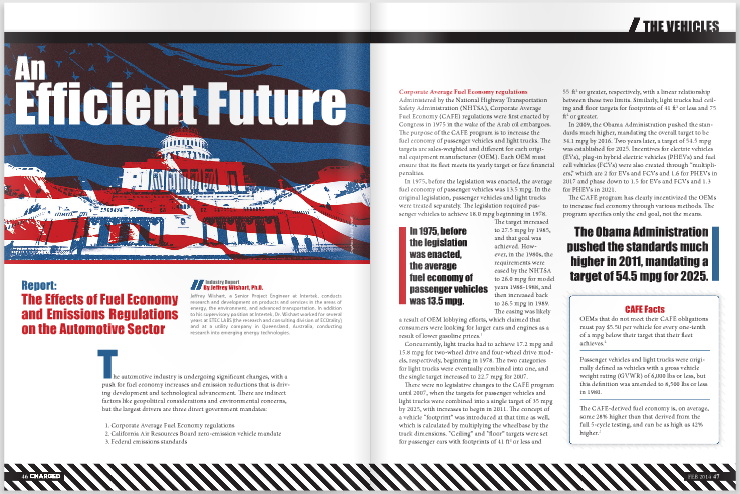By Jeffrey Wishart, a Senior Project Engineer at Intertek, conducts research and development on products and services in the areas of energy, the environment, and advanced transportation. In addition to his supervisory position at Intertek, Dr. Wishart worked for several years at ETEC LABS (the research and consulting division of ECOtality) and at a utility company in Queensland, Australia, conducting research into emerging energy technologies.
The automotive industry is undergoing significant changes, with a push for fuel economy increases and emission reductions that is driving development and technological advancement. There are indirect factors like geopolitical considerations and environmental concerns, but the largest drivers are three direct government mandates:
- Corporate Average Fuel Economy regulations
- California Air Resources Board zero-emission vehicle mandate
- Federal emissions standards
Corporate Average Fuel Economy regulations
Administered by the National Highway Transportation Safety Administration (NHTSA), Corporate Average Fuel Economy (CAFE) regulations were first enacted by Congress in 1975 in the wake of the Arab oil embargoes. The purpose of the CAFE program is to increase the fuel economy of passenger vehicles and light trucks. The targets are sales-weighted and different for each original equipment manufacturer (OEM). Each OEM must ensure that its fleet meets its yearly target or face financial penalties.
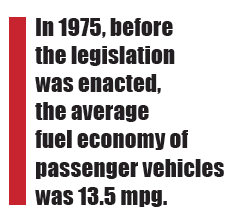

Concurrently, light trucks had to achieve 17.2 mpg and 15.8 mpg for two-wheel drive and four-wheel drive models, respectively, beginning in 1978. The two categories for light trucks were eventually combined into one, and the single target increased to 22.7 mpg for 2007.
There were no legislative changes to the CAFE program until 2007, when the targets for passenger vehicles and light trucks were combined into a single target of 35 mpg by 2025, with increases to begin in 2011. The concept of a vehicle “footprint” was introduced at that time as well, which is calculated by multiplying the wheelbase by the track dimensions. “Ceiling” and “floor” targets were set for passenger cars with footprints of 41 ft2 or less and 55-ft2 or greater, respectively, with a linear relationship between these two limits. Similarly, light trucks had ceiling and floor targets for footprints of 41 ft2 or less and 75 ft2 or greater.
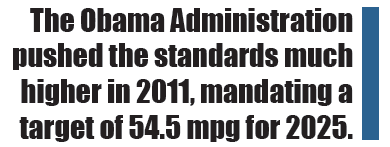

The CAFE program has clearly incentivized the OEMs to increase fuel economy through various methods. The program specifies only the end goal, not the means.
California Air Resources Board ZEV mandate
The California Air Resources Board (CARB) is the department within the California Environmental Protection Agency tasked with improving the air quality of the state, and has vehicle emissions regulations as part of its mandate. CARB first developed its zero-emission vehicle (ZEV) mandate as part of the overall Low-Emission Vehicle regulations in 1990. It set a target for 1998 that 2% of vehicles for sale by large OEMs had to be ZEVs, increasing to 5% in 2001, and 10% in 2003. Due to several factors, including the technological and cost limitations associated with ZEV market introduction and OEM lobbying, the interim 2001 target was removed and the 2003 target was modified to include 2% ZEVs, 2% Advanced Technology partial-ZEVs, and 6% partial-ZEVs.
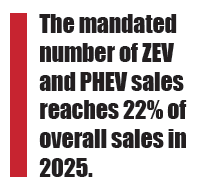

Many of the new ZEV vehicles have been delivered solely to the California market, and are known as “compliance vehicles” because they are only built to “comply” with the CARB mandate. There is little doubt that the CARB mandate has resulted in more ZEV development than would have happened in its absence, and the ever-increasing requirement is likely to stimulate further technological advancements.
Federal emissions standards
The federal emissions standards were first introduced as part of the Clean Air Act of 1963. The standards were enacted country-wide in 1968, and are currently enforced by the Environmental Protection Agency (EPA) for light-duty vehicles. In 1990, the Clean Air Act was amended and the standards strengthened. In the same year, California adopted the LEV regulations, which are more stringent than the federal standards. The standards regulate a variety of tailpipe emissions called criteria air contaminants (particulate matter, carbon monoxide, various nitrous oxides, total hydrocarbons, and non-methane hydrocarbons), and the federal standards have been tightened gradually through multiple phases6:
Tier 1: Phased in between 1994 and 1997, Tier 1 required vehicles to reach standards that placed cars into a single category and light trucks into four categories, based on weight.
National LEV program: Beginning in 1999 for some northeastern states and nationally in 2001, this program was voluntary and served as a transition between the Tier 1 and Tier 2 standards.
Tier 2: Phased in between 2004 and 2009, Tier 2 put all light-duty vehicles in the same emissions category, which was more stringent than Tier 1 standards. Light-duty trucks and medium-duty passenger vehicles were also now included in the standard. Vehicles are assigned to a “bin” number between 1 and 11 (where 1 is the cleanest and 11 the dirtiest); however, Bin 11 was never applicable to passenger vehicles. Bins 9 and 10 were eliminated after 2006 for passenger cars, and after 2008, Bins 9 through 11 were eliminated for light-duty trucks and medium-duty vehicles. This means that currently, Bin 8 is the highest level of emissions that an applicable vehicle can have and be sold in the US. Tier 2 standards also reduced the sulfur content from a maximum of 200 ppm in 2004 to a maximum of 80 ppm in 2006. Diesel fuel was required to reduce the level of sulfur to a maximum of 15 ppm in the same year.
Tier 3: These standards have been proposed, but not implemented at present, and the Tier 2 standards remain the current law. The Tier 3 standard would harmonize the federal emissions standard with California’s Low-Emission Vehicle program, which has already been implemented (for years 1994 through 2003) and strengthened for LEV II (phased in between 2004 and 2010) and for LEV III (to be phased in between 2015 and 2025)7. The Tier 3 standard would continue the reduction in tailpipe and evaporative emissions from vehicles and expand the coverage to some heavy-duty vehicles. The sulfur content of gasoline would also continue to be decreased.
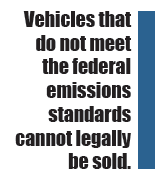

Mandated innovation
While there is some debate about the amount of new technology that is needed to meet all three of these mandates, the targets are sufficiently ambitious that the OEMs must make significant changes to their fleets in the coming decade. As a result, there has been rapid development across the automotive industry, with each OEM devising a different strategy for meeting the targets.
Conventional powertrain technology development: engines, lubricants, transmissions
It can be argued that the era of large engines in passenger vehicles is mostly over. However, consumers today still want the same power and torque, in addition to fuel efficiency. Smaller displacement engines are being incorporated in cars (4-cylinders are replacing the V-8s), but automakers are exploring the use of superchargers and turbochargers to maintain power and torque at the desired levels (Ford’s celebrated EcoBoost engines are a prime example). These advanced engines often need specialized lubricants, use transmissions with higher numbers of gears, and must also run cleanly as emissions requirements become more strict. Development of conventional powertrain technologies like engines, lubricants and transmissions is generally an underappreciated avenue of meeting the government mandates for the OEMs, and all of the major automakers are diligently pursuing them.
Vehicle weight reduction
In a recent DOE study10, it was demonstrated that a 10% reduction in vehicle mass can result in a 3-4% reduction in fuel consumption. Therefore, making vehicles lighter is a key component in reaching fuel economy mandates. In place of the traditional steel used in a car or truck, more lightweight materials are being used.
Current trends for advanced materials in the automotive industry are different for structural and non-structural materials. In structural materials, the trend is increased usage of aluminum, high-strength steel, Glass Fiber Reinforced Polymer, Carbon Fiber Reinforced Polymer, and a hybrid of metal joined to polymers. Structural foam is beginning to be used as well. For non-structural components, the trends include more natural fiber polymers, unfilled thermoplastics, and foamed polymers.
The new materials cannot simply reduce weight. They must equal or improve upon the materials they replace in terms of structure, safety to the occupants and performance. From a manufacturing standpoint, the process for producing and forming these advanced materials, and the full cycle time, needs to be comparable to conventional materials. The challenge of joining dissimilar materials must be overcome. Some advanced materials have inherent properties that allow for more thermal expansion, creep and warpage, and these concerns must be addressed whenever the materials are used. Finally, the costs of advanced materials must be reduced or their introduction will be severely hampered.
Alternative fuel adoption
Alternative fuels with lower emissions than gasoline or diesel include ethanol, natural gas, propane, and hydrogen. All four are used in modified internal combustion engine vehicles, and hydrogen is also used in FCVs.
With the exception of flex-fuel vehicles (FFVs), there aren’t currently many alternative fuel models in production. FFVs have been on the market for over 100 years, and in fact, the Ford Model T was a flex-fuel vehicle, with gasoline and ethanol as the fuel options. There are currently some 15 million FFVs11 in the US, and the modern FFV can be fueled with either gasoline or E85, a blend of 51-85% ethanol and gasoline12, with only minor mechanical differences.
In 2011, GM led the way with 25 models, followed by 18 by Ford and 11 by Chrysler, which were nearly double the available models in 2007. The foreign OEMs marketed the balance, with 16 models spread amongst them. Sales of FFVs are higher in the Midwest due to proximity to the corn farmers and local support for this fuel, along with more ethanol infrastructure. Outside the Midwest, the infrastructure is far less common, and sales of FFVs are much lower. It is also common for an owner of an FFV to be unaware of the flex-fuel capability of the vehicle.
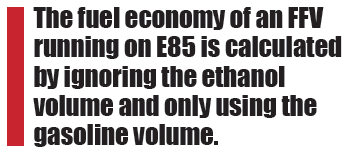

Ethanol is also blended with gasoline for regular fuel – up to 10%, as part of the Energy Security and Independence Act of 2007. This act mandated that a growing amount of renewable fuels be part of the conventional fuel system, from 9 billion gallons in 2008 to 36 billion gallons by 2022. In 2013, 14 billion gallons of corn ethanol and 2.75 billion gallons of more advanced biofuels such as cellulosic ethanol and biodiesel were blended.15 The ethanol mandate is very controversial and is seen by critics as an unnecessary subsidy of corn farmers to make a biofuel, with debatable environmental benefits, that drives up food prices (especially in Latin America). A push to move to a 15% ethanol blend is currently being fought between ethanol and OEM lobbies; the latter believe that more ethanol in the blend will harm vehicle engines.
More advanced biofuels are less controversial but have problems with scaling to become significant.
Other than FFVs, alternative fuel vehicles (AFVs) are largely a mix of prototypes and low-volume production vehicles, mostly in fleet operations. In 2011, the total number of AFVs (excluding the 67,000-plus vehicles powered by electricity, which are often included in the AFV total) was 1.12 million vehicles. There were 139,000 liquid propane gas (LPG) vehicles, 118,000 compressed natural gas (CNG) vehicles, 3,436 liquefied natural gas (LNG) vehicles and 527 hydrogen vehicles. As a whole, the number of AFVs increased by over 10% from 1995-2011.16
The compressed natural gas Honda Civic NGV is selling in modest numbers, and Honda also has the FCX Clarity FCV, which has been available for lease at $600/month in California since 2008 (there are only approximately 50 lessees17). Ford has announced the F-150 in CNG and LPG versions for the 2014 model year. These examples and the above numbers illustrate that AFV models do not account for a significant proportion of the US fleet. This may change with a recent push for more natural gas vehicles, most notably highlighted in the 2014 State of the Union address by President Obama. However, there is no guarantee that any alternative fuel will garner significant market share.
Powertrain electrification
Many automotive insiders believe that the electrification of vehicles will only accelerate in the future. Vehicle electrification can take many forms. At one end of the spectrum, more robust 12 V batteries are required as more amenities are packed into vehicles. Next up are stop-start vehicles that shut down the engine at stops in order to save fuel. When the engine is off, at a red light for example, the alternator is not charging the battery or supplying power for amenities and peripheral equipment like air conditioning, windshield wipers, and dashboard lighting. Many European vehicles sold now have stop-start capability, and it will begin to become commonplace in the US in the near future – with a possible fuel economy improvement of up to 10%. Some vehicles sold in the US already offer it, like the Ford Fusion, which offers a stop-start feature as a $295 add-on. Further along the electrification line are micro-hybrids, which have stop-start capability as well as an electric motor connected to the drivetrain. Stop-start vehicles and micro-hybrid vehicles are often confused, but micro-hybrids differ by providing regenerative braking capabilities.
Beyond micro-hybrid vehicles, a high-voltage (HV) battery can be used for propulsion and regenerative braking energy storage. A mild hybrid like the Chevrolet Malibu ECO has stop-start capability, and an electric motor assists the engine in propelling the vehicle at launch and during accelerations. The HV battery is recharged via the engine or through regenerative braking.
The next step along the spectrum is a full hybrid like the Toyota Prius. A full hybrid has stop-start capability, and its electric motor is sufficiently powerful to allow for all-electric driving capability, although some full hybrids only have all-electric launches. Micro, mild, and full hybrids make up the hybrid electric vehicle (HEV) family.
HEVs are much more efficient than conventional vehicles, but in order to achieve a truly significant reduction in petroleum usage, vehicles need to be propelled by off-board energy. With PHEVs, much more of the propulsion energy is electrical, and the efficiency of the vehicle increases dramatically.
The opposite end of the vehicle electrification spectrum to a conventional vehicle is the EV. With no ICE, the efficiency is some three times higher than a conventional vehicle. The drawbacks include shorter ranges and longer refueling times. However, for a commuter vehicle that travels a constant distance on a daily basis (which describes a majority of driving in this country), the EV is tough to beat. Furthermore, the EV is a ZEV, and can dramatically reduce local pollution and GHG emissions.
OEMs also have the option of a hybrid (pardon the pun) of an AFV and vehicle electrification in the FCV. FCVs have zero emissions at the tailpipe, and although they are less efficient than EVs, refueling time and range can be comparable to a conventional vehicle.
Off-cycle credits
Off-cycle credits are methods for reducing fuel consumption that are not reflected by dynamometer testing. For example, grill shutters that can close at highway speeds to reduce air drag will give real-world fuel economy numbers that will not show up on the EPA fuel economy label, thereby saving the consumer money. As a result, the federal government gives credit to the OEMs for including these technologies by allowing the OEM to adjust the EPA fuel economy number to help meet the CAFE fleet requirement. Along with active grill shutters, technologies like electric heat pumps, stop-start systems, high-efficiency lights, and solar panels can earn the OEM off-cycle credits. It should be noted that stop-start systems do affect the dynamometer test results, but the test result effects are small and the larger, real-world effects are not captured.18 The off-cycle credits are set to be implemented in the 2017-2025 timeframe.
An efficient future
Big changes are afoot in the automotive industry, with no certain path forward. While the government mandates mean more efficient vehicles with fewer emissions, anybody who claims to know the exact mix of methods to meet the various mandates is, as the saying goes, either Lord, Liar, or Lunatic. Each OEM will direct its R&D in an idiosyncratic direction, and the ultimate decider will be the consumer.
Only time will tell how the market evolves for conventional vehicles, electrified vehicles, alternative fuels, and complementary technologies. The market of 2025 will no doubt be very different from the one we have today, and that can only be seen as a mark of progress.
References
For more details about fuel economy and emissions regulations, consult our references:
[1] Government Accountability Office (2007), “Vehicle Fuel Economy: Reforming Fuel Standards Could Help Reduce Oil Consumption by Cars and Light Trucks, and Other Options Could Complement These Standards,” Report to the Chairman, Committee on Commerce, Science and Transportation, U.S. Senate.
[2] Congressional Budget Office (2003), “The Economic Costs of Fuel Economy Standards Versus a Gasoline Tax,” accessed February 11, 2014.
[3] Union of Concerned Scientists (2011), “Translating New Auto Standards into On-Road Fuel Efficiency,” accessed January 25, 2014.
[4] California Air Resources Board (2012), “Final Regulation Order: §1962.2 Zero Emission Vehicle Standards for 2018 and subsequent Model Year Passenger Cars, Light-Duty Trucks, and Medium-Duty Vehicles,” accessed January 21, 2014.
[5] S. Blanco (2013), “Tesla sells most ZEV green car credits, GM tops buyer list,” http://green.autoblog.com, accessed February 18, 2014.
[6] DieselNet, Emissions Standards-United States, Cars and Light-Duty Trucks – Tier 1, http://www.dieselnet.com/standards/us/ld.php, accessed January 24, 2014.
[7] California Air Resources Board (2013), “The California Low-Emission Vehicle Regulations,” accessed February 17, 2014.
[8] Ford media release (2014), “All-New Ford F-150 Redefines Full-Size Trucks as the Toughest, Smartest, Most Capable F-150 Ever,” accessed February 17, 2014.
[9] B. Walsh (2014), “White House to Toughen Fuel Standards for Heavy-Duty Vehicles,” accessed February 18, 2014.
[10] R. Carlson, H. Lohse-Busch, J. Diez, and J. Gibbs (2013), “The Measured Impact of Vehicle Mass on Road Load Forces and Energy Consumption for a BEV, HEV, and ICE Vehicle,” SAE Int. J. Alt. Power. 2(1):105-114, 2013, doi: 10.4271/2013-01-1457.
[11] J. Motavalli (2012), “Flex-fuel amendment makes for strange bedfellows”, New York Times, March 1, 2012, accessed Feb 13, 2014.
[12] National Renewable Energy Laboratory, http://www.afdc.energy.gov/vehicles/flexible_fuel.html, accessed February 14, 2014.
[13] S. Davis, S. Diegel, and R. Boundy (2013), “Transportation Energy Data Book: Edition 32”, Office of Energy Efficiency and Renewable Energy, US Department of Energy, pp. 6-3.
[14] P. Bedard (2006), “Ethanol promises: Farm-raising our own energy independence: Could it happen?”, Car and Driver, accessed February 24, 2014.
[15] C. Kenny (2014), “Congress Wakes Up to the Bad News About Biofuels”, http://www.businessweek.com, accessed February 12, 2014.
[16] S. Davis, S. Diegel, and R. Boundy (2013), “Transportation Energy Data Book: Edition 32”, Office of Energy Efficiency and Renewable Energy, U.S., Department of Energy, pp. 6-3.
[17] A. Max (2010), “Hydrogen still in the eco-car race”, http://www.timesfreepress.com, accessed February 11, 2014.
[18] J. Berkowitz and C. Csere (2012), “The CAFE Numbers Game: Making Sense of the New Fuel-Economy Regulations”, http://www.caranddriver.com, accessed February 10, 2014.
This article originally appeared in Charged Issue 12 – FEB 2014




